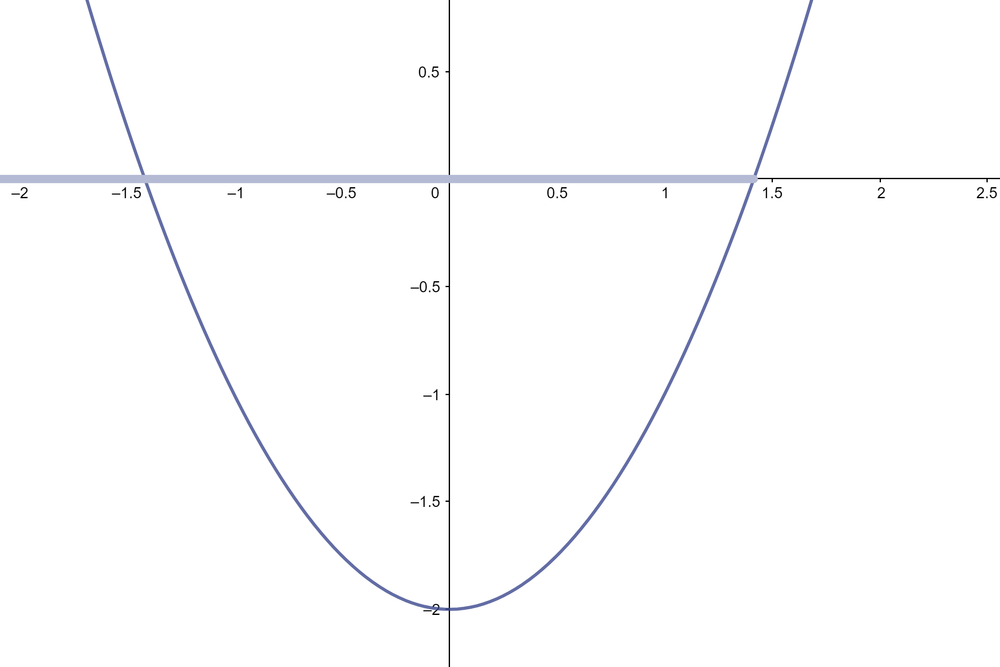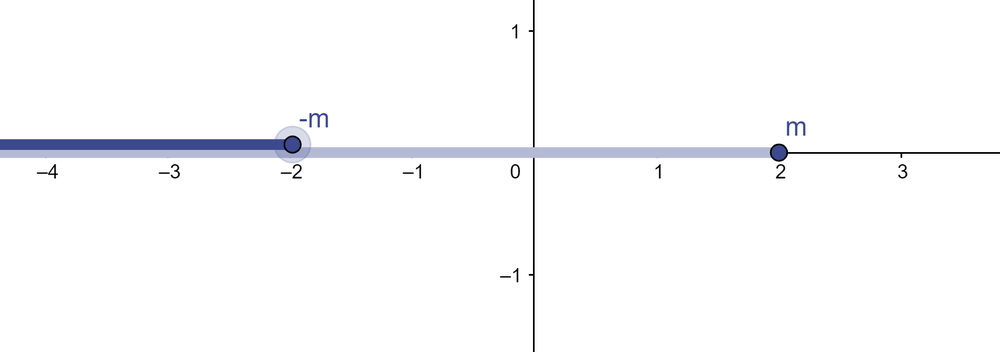חתכי דדקינד: הבדלים בין גרסאות בדף
| שורה 137: | שורה 137: | ||
*לכן <math>t=xy\in AB</math>. | *לכן <math>t=xy\in AB</math>. | ||
*כיוון ש<math>x</math> אינו חסם מלעיל של <math>A</math> קיים <math>x<z\in A</math> ולכן <math>xy<zy\in A</math> בסתירה. | *כיוון ש<math>x</math> אינו חסם מלעיל של <math>A</math> קיים <math>x<z\in A</math> ולכן <math>xy<zy\in A</math> בסתירה. | ||
*אם <math>t\not\in AB</math> צ"ל כי <math>t</math> חסם מלעיל. | *אם <math>t\not\in AB</math> צ"ל כי <math>t</math> חסם מלעיל. | ||
*נב"ש כי <math>t</math> אינו חסם מלעיל, לכן יש בקבוצה איבר גדול ממנו. | |||
*כיוון ש <math>t\not\in AB</math> נובע כי <math>t>0</math>, ולכן האיבר שגדול ממנו הוא מהצורה <math>t<xy</math>. | |||
*לכן <math>\frac{t}{y}<x</math>, נבחר <math>x_1 =\frac{t}{y}<x</math>. | |||
*כיוון ש<math>x_1 <x</math> נובע כי <math>x_1 \in A</math>. | |||
*לכן <math>t=x_1 y\in A\cdot B</math> בסתירה. | |||
===חתך היחידה=== | ===חתך היחידה=== | ||
גרסה מ־15:50, 26 במרץ 2022
הקדמה
- אנחנו מעוניינים שבמערכת המספרים שלנו יהיה פתרון למשוואה
- הרי אחרת, מה המרחק מהנקודה
- האם ייתכן שהפרבולה
- כיוון שאין פתרון למשוואה זו בשדה הרציונאליים, אנחנו רוצים לבנות את שדה הממשיים.
- כיצד ניתן לתאר את נקודת החיתוך החיובית של הפרבולה
(נבנה באמצעות גאוגברה.)
- ובכן, ניתן לומר שציר המספרים מתחלק לשניים - לפני שורש שתיים ואחרי שורש שתיים.
- כלומר, אולי אנחנו יכולים לייצג את נקודת החיתוך על ידי אוסף הנקודות שקטנות ממנה
- הרעיון הזה של חיתוך ציר הרציונאליים סביב נקודה בלתי קיימת הוליד את חתכי דדקינד.
חתכי דדקינד
- הגדרה: חתך דדקינד הוא קבוצה
- לכל
- הערות ותזכורות:
- חסם מלעיל של קבוצה הוא מספר שגדול יותר מכל איברי הקבוצה.
- בחתך דדקינד אין מספר גדול ביותר, אחרת זה היה חסם מלעיל ששיך לקבוצה. זה משול לחצי האבוקדו ללא הגרעין.
- בחתך המייצג מספר שאינו רציונאלי, כמו שורש שתיים, גם במשלים של החתך אין מספר קטן ביותר, זה משול לשני חצאי אבוקדו ללא גרעין כלל.
- אם מספר שייך לחתך, בוודאי כל מספר נמוך ממנו שייך לחתך הרי לא ייתכן שמספר נמוך ממנו הוא חסם מלעיל.
- הקרן באיור לעיל היא חתך דדקינד שתפקידו להגדיר את שורש שתיים.
- כיצד ניתן להתייחס לקבוצות כאלה בתור מספרים?
- עלינו להגיד פעולות בין חתכי דדקינד ולהוכיח שמדובר בשדה.
- כאשר נגדיר את הפעולות, נזכור שמטרתינו היא להגדיר את הנקודות "החסרות" על הציר.
חיבור חתכי דדקינד
- יהיו שתי חתכים
- החיבור הוא חתך דדקינד בעצמו:
- כיוון שA,B אינן ריקות גם A+B אינה ריקה.
- סכום חסמי מלעיל של A וB חוסם את A+B.
- יהי
- יהי
חתך האפס
- נגדיר את חתך האפס, בהמשך נוכיח שהוא נייטרלי לחיבור.
נגדי
- יהי חתך A, נגדיר את הנגדי:
- לדוגמא
- הנגדי הוא חתך דדקינד בעצמו:
- הנגדי לא ריק:
- כיוון שA חסומה מלעיל יש לה חסם, וכל המספרים שקטנים ממינוס החסם שייכים לנגדי, ולכן
- כיוון שA חסומה מלעיל יש לה חסם, וכל המספרים שקטנים ממינוס החסם שייכים לנגדי, ולכן
- הנגדי חסום מלעיל:
- יהי
- לכל
- בעצם הנגדי של כל איבר בA הוא חסם מלעיל של
- יהי
- כל איבר בנגדי אינו חסם מלעיל:
- לכל איבר בנגדי
- לכל איבר בנגדי
- אם איבר אינו חסם מלעיל, הוא שייך לנגדי:
- נניח
- נניח
- הנגדי לא ריק:
יחס סדר
- יחס ההכלה הוא יחס סדר לינארי (מלא) על קבוצת חתכי דדקינד
- הוכחה:
- יהיו שני חתכים A,B.
- אם קיים
- אחרת, לכל
- נגדיר את החתכים החיוביים להיות כל החתכים A כך ש
- טענה:
- הוכחה:
- ראשית נניח כי
- כלומר בעצם
- לכן לכל
- כלומר כל האיברים ב
- כלומר בעצם
- בכיוון ההפוך, נניח כי
- לכן כל האיברים ב
- אם קיים
- לכן כל האיברים ב
- לכן כל המספרים השליליים שייכים לA, כלומר
- ראשית נניח כי
כפל חתכי דדקינד
- יהיו שני חתכי דדקינד אי שליליים
- אם A שלילי, וB אי שלילי, נגדיר:
- אם A אי שלילי, וB שלילי, נגדיר:
- אם A,B שליליים נגדיר:
הוכחה שהמכפלה נותנת חתך דדקינד
- יהיו שני חתכי דדקינד אי שליליים
- ברור שהמכפלה לא ריקה כיוון ש
- כיוון שA,B חתכי דדקינד מדובר בקבוצות חסומות, אז קיימים חסמי מלעיל
- לכל
- אם
- אם
- לכן
- כיוון ש
- אם
- נב"ש כי
- כיוון ש
- לכן
- כיוון ש
- לכן
חתך היחידה
- נגדיר את חתך היחידה, בהמשך נוכיח שהוא נייטרלי לכפל.
הופכי
- אם A חיובי נגדיר את ההופכי שלו להיות
- אם A שלילי נגדיר את ההופכי שלו להיות
שדה הממשיים
הגדרת המספרים הממשיים
- הגדרה:
- נוכיח שמדובר בשדה סדור ביחס לפעולות החיבור והכפל ויחס הסדר שהגדרנו לעיל, ולאחר מכן נתאר את הייצוג העשרוני של המספרים הממשיים.
שלמות הממשיים
- תהי
הוכחה
- נסמן ב
- נוכיח כי האיחוד הכללי של כל חתכי הדדקינד הוא גם חתך דדקינד.
- כיוון ש
- כיוון ש
- לפי יחס הסדר מתקיים כי
- כיוון שלכל
- לכן
- כיוון ש
- נוכיח כי
- אם
- אם
- מצד שני, אם
- אם
- ברור כי לכל
- נוכיח כי
- נב"ש כי קיים
- לכן קיים
- לכן קיים
- לכן


